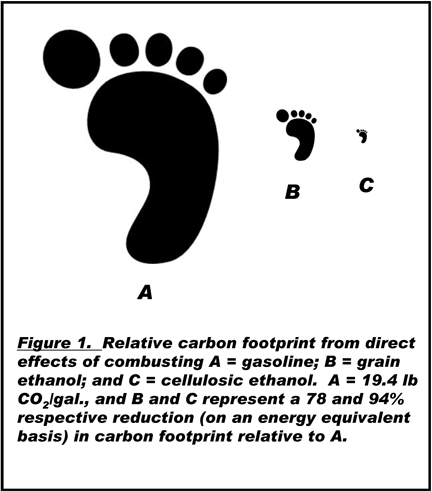What is the direct carbon footprint of biofuel relative to gasoline?
Editor’s note: This article is from the archives of the MSU Crop Advisory Team Alerts. Check the label of any pesticide referenced to ensure your use is included.
In the mass media lately we have been hearing a lot about “carbon footprints,” “greenhouse gases,” “climate change,” and “global warming.” Unfortunately, some of the information is non-defensible, inaccurate, or misrepresented. This muddling of the facts has been especially prevalent when assessing the environmental impact of biofuels. Further complicating the issue are non-scientifically valid efforts to assess and assign indirect carbon costs such as land use changes occurring on other continents. Land use change in foreign countries is as old as history itself and the multiplicity of factors that drive it are far too complex to attribute solely to biofuel production in the United States. Furthermore, serious errors have been uncovered in the methodology used in these indirect land use change assessments such as ignoring the fact that approximately half of the feed value of corn grain is maintained in co-products such as distillers grain when corn is converted to ethanol.
However, it is fairly straight forward to compare the direct carbon footprint of gasoline relative to a biofuel such as corn ethanol. According to the USEPA, for each gallon of gasoline burned in an automobile, 19.4 lb of CO2 are emitted to the atmosphere. This is just from the carbon actually contained in the gasoline and does not include the carbon from extracting the crude oil, transporting the crude oil, refining the crude oil, and transporting the gasoline. Furthermore, prior to refining, the carbon from gasoline was safely sequestered below the earth’s surface for hundreds of millions of years. It is basically new carbon added to the atmosphere – 2.7 trillion lbs. of new CO2 annually from cars in the United States alone!
By comparison, the net global warming potential of an equivalent amount of ethanol (1.4 gallons of ethanol per gallon of gasoline) is significantly lower. This is because the carbon contained in biofuel ethanol is autotrophically derived, meaning it came from the atmosphere in the first place (through photosynthesis of the corn plant from which the ethanol was made). When burned, the ethanol carbon is simply recycled back to the atmosphere from where it came. It is not new carbon added to the atmosphere. However, using international carbon accounting practices established by the International Panel on Climate Change (IPCC), we should consider the fossil fuel carbon used in producing ethanol. Using typical Michigan corn production inputs, a 150 bushel per acre corn crop will require approximately 28,000 seeds; 150 lb of N, 55 lb of P2O5, and 85 lb of K2O fertilizers; 2 quarts of herbicide, and 5 gallons of fuel/lub/oil. On a per acre basis, these inputs would run up a carbon debt of about 1250 lb CO2 per acre. The same acre would produce about 420 gallons of ethanol, giving a carbon footprint of only 2.9 lb. of CO2 per gallon of ethanol. Or, on a gasoline equivalent basis, 4.2 lb of CO2 emitted for each 1.4 gallons of ethanol burned which represents a 78 percent reduction in net global warming potential simply by using ethanol instead of gasoline. Even more promising, the carbon footprint of second generation biofuels made from perennial grasses will be substantially lower yet – estimated at a 94 percent reduction from gasoline!



 Print
Print Email
Email





